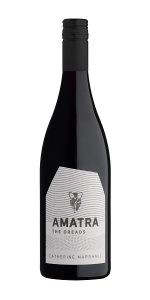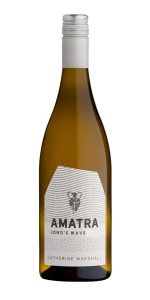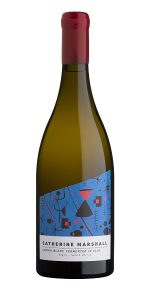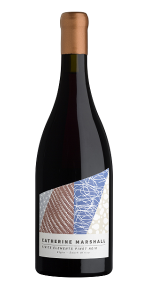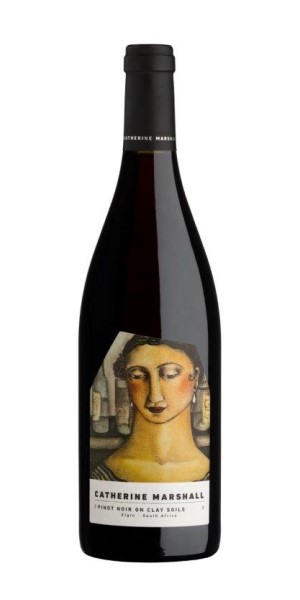
Technical Analysis
Purity, vibrancy and harmonious balance result from the careful selection and blending of specific clones grown on clay soils in the cool Elgin Valley.
Tasting note
Layered and textured truffle savouriness and earthy forest floor interwoven with concentrated black cherry compote harmoniously supported by mineral textured tannins.
Vinification details
Bunches were de-stemmed with some crushing and berries were hand sorted at the crusher. The whole berry fraction was about 50% and cold soaked for two days in 500kg batches before yeast activity began. Fermentation was in open top vats where spontaneous fermentation and some inoculated commercial Pinot yeast culture was induced. Juice and skins were punched down (pigeage) and turned daily to control even heat distribution between the skin cap on top and must juice below. Tannin and flavour extractions from the skins were carefully monitored at that stage. Once fermentation was completed, the bins were tasted and selected on tannin and flavour attributes and manually pressed in an 800kg capacity stainless steel basket press. The bin combinations selected were kept as separate fractions to create as many blending profiles as possible for the final assemblage. The secondary Malo-lactic fermentation was completed in 225 Litre oak casks where, once all the malic acid has converted to lactic acid, was racked off the solid lees (dead yeast cells and solids) and further matured for 11 months in a combination of new, second, third and fourth filled Burgundy coopered casks. Once maturation was completed, each barrel was assessed for premium status and the resultant blend of the chosen barrels were assembled and lightly filtered to bottle.
Tasting video
With owner and winemaker Cathy Marshall.

Technical Analysis
Purity, vibrancy and harmonious balance result from the careful selection and blending of specific clones grown on clay soils in the cool Elgin Valley.
Tasting note
Layered and textured truffle savouriness and earthy forest floor interwoven with concentrated black cherry compote harmoniously supported by mineral textured tannins.
Vinification details
Bunches were de-stemmed with some crushing and berries were hand sorted at the crusher. The whole berry fraction was about 50% and cold soaked for two days in 500kg batches before yeast activity began. Fermentation was in open top vats where spontaneous fermentation and some inoculated commercial Pinot yeast culture was induced. Juice and skins were punched down (pigeage) and turned daily to control even heat distribution between the skin cap on top and must juice below. Tannin and flavour extractions from the skins were carefully monitored at that stage. Once fermentation was completed, the bins were tasted and selected on tannin and flavour attributes and manually pressed in an 800kg capacity stainless steel basket press. The bin combinations selected were kept as separate fractions to create as many blending profiles as possible for the final assemblage. The secondary Malo-lactic fermentation was completed in 225 Litre oak casks where, once all the malic acid has converted to lactic acid, was racked off the solid lees (dead yeast cells and solids) and further matured for 11 months in a combination of new, second, third and fourth filled Burgundy coopered casks. Once maturation was completed, each barrel was assessed for premium status and the resultant blend of the chosen barrels were assembled and lightly filtered to bottle.
AWARDS
Tim Atkin MW: 94 pts
Wine Advocate: 91 pts

Technical Analysis
Purity, vibrancy and harmonious balance result from the careful selection and blending of specific clones grown on clay soils in the cool Elgin Valley.
Tasting note
Layered and textured truffle savouriness and earthy forest floor interwoven with concentrated black cherry compote harmoniously supported by mineral textured tannins.
Vinification details
Bunches were de-stemmed with some crushing and berries were hand sorted at the crusher. The whole berry fraction was about 50% and cold soaked for two days in 500kg batches before yeast activity began. Fermentation was in open top vats where spontaneous fermentation and some inoculated commercial Pinot yeast culture was induced. Juice and skins were punched down (pigeage) and turned daily to control even heat distribution between the skin cap on top and must juice below. Tannin and flavour extractions from the skins were carefully monitored at that stage. Once fermentation was completed, the bins were tasted and selected on tannin and flavour attributes and manually pressed in an 800kg capacity stainless steel basket press. The bin combinations selected were kept as separate fractions to create as many blending profiles as possible for the final assemblage. The secondary Malo-lactic fermentation was completed in 225 Litre oak casks where, once all the malic acid has converted to lactic acid, was racked off the solid lees (dead yeast cells and solids) and further matured for 11 months in a combination of new, second, third and fourth filled Burgundy coopered casks. Once maturation was completed, each barrel was assessed for premium status and the resultant blend of the chosen barrels were assembled and lightly filtered to bottle.
AWARDS
Tim Atkin MW: 94 pts
Platter: 94 pts

Technical Analysis
Purity, vibrancy and harmonious balance result from the careful selection and blending of specific clones grown on clay soils in the cool Elgin Valley.
Tasting note
Layered and textured truffle savouriness and earthy forest floor interwoven with concentrated black cherry compote harmoniously supported by mineral textured tannins
Vinification details
Bunches were de-stemmed with some crushing and berries were hand sorted at the crusher. The whole berry fraction was about 50% and cold soaked for two days in 500kg batches before yeast activity began. Fermentation was in open top vats where spontaneous fermentation and some inoculated commercial Pinot yeast culture was induced. Juice and skins were punched down (pigeage) and turned daily to control even heat distribution between the skin cap on top and must juice below. Tannin and flavour extractions from the skins were carefully monitored at that stage. Once fermentation was completed, the bins were tasted and selected on tannin and flavour attributes and manually pressed in an 800kg capacity stainless steel basket press. The bin combinations selected were kept as separate fractions to create as many blending profiles as possible for the final assemblage. The secondary Malo-lactic fermentation was completed in 225 Litre oak casks where, once all the malic acid has converted to lactic acid, was racked off the solid lees (dead yeast cells and solids) and further matured for 11 months in a combination of new, second, third and fourth filled Burgundy coopered casks. Once maturation was completed, each barrel was assessed for premium status and the resultant blend of the chosen barrels were assembled and lightly filtered to bottle.
AWARDS
Tim Atkin MW: 94 pts
Platter: 93 pts

Technical Analysis
Purity, vibrancy and harmonious balance result from the careful selection and blending of specific clones grown on clay soils in the cool Elgin Valley.
Tasting note
Layered and textured truffle savouriness and earthy forest floor characters are interwoven with concentrated black cherry compote and harmoniously supported by mineral tannins. Although the wine is approachable in its primary stage with fresh cherry and red berry components evident at youth, the wine will age for at least 10 years where primary components will evolve to tertiary forest floor, truffle, earthy and savoury notes that are typical in great Burgundy examples.
Vinification details
Bunches were de-stemmed with some crushing and berries hand sorted at the crusher. The whole berry fraction amounted to about 50% and was cold soaked for two days in 500kg batches before yeast activity began. Fermentation was in open top vats – some was spontaneous, while other batches were inoculated with a Pinot yeast culture. Juice and skin were punched down and turned daily to control even heat distribution between the skin cap on top and must juice below. Tannin and flavour extractions from the skins were carefully monitored at this stage.
Once fermentation was completed, the bins were tasted and selected on tannin and flavour attributes and manually pressed in an 800kg capacity stainless steel basket press. The bin combinations selected were kept as separate fractions to create as many blending profiles as possible for the final assemblage. The secondary malolactic fermentation was completed in 225 and 300L oak casks where, once all the malic acid had converted to lactic acid, it was racked off the solid lees and further matured for 11 months in a combination of new, second-, third- and fourth-filled Burgundy coopered casks.
Once maturation was complete, each barrel was assessed and the resultant blend of the chosen barrels were assembled and lightly filtered to bottle.

Technical Analysis
Purity, vibrancy and harmonious balance result from the careful selection and blending of specific clones grown on clay soils in the cool Elgin Valley.
Tasting note
Layered and textured truffle savouriness and earthy forest floor characters are interwoven with concentrated black cherry compote and harmoniously supported by mineral tannins. Although the wine is approachable in its primary stage with fresh cherry and red berry components evident at youth, the wine will age for at least 10 years where primary components will evolve to tertiary forest floor, truffle, earthy and savoury notes that are typical in great Burgundy examples.
Vintage conditions
2018 was another long, dry growing season, like 2015, 2016 and 2017 with more extreme drought conditions and severe water restrictions in place as dams were critically low throughout the year.
Vinification details
Bunches were de-stemmed with some crushing and berries hand sorted at the crusher. The whole berry fraction amounted to about 50% and was cold soaked for two days in 500kg batches before yeast activity began. Fermentation was in open top vats – some was spontaneous, while other batches were inoculated with a Pinot yeast culture. Juice and skin were punched down and turned daily to control even heat distribution between the skin cap on top and must juice below. Tannin and flavour extractions from the skins were carefully monitored at this stage.
Once fermentation was completed, the bins were tasted and selected on tannin and flavour attributes and manually pressed in an 800kg capacity stainless steel basket press. The bin combinations selected were kept as separate fractions to create as many blending profiles as possible for the final assemblage. The secondary malolactic fermentation was completed in 225 and 300L oak casks where, once all the malic acid had converted to lactic acid, it was racked off the solid lees and further matured for 11 months in a combination of new, second-, third- and fourth-filled Burgundy coopered casks.
Once maturation was complete, each barrel was assessed and the resultant blend of the chosen barrels were assembled and lightly filtered to bottle.


